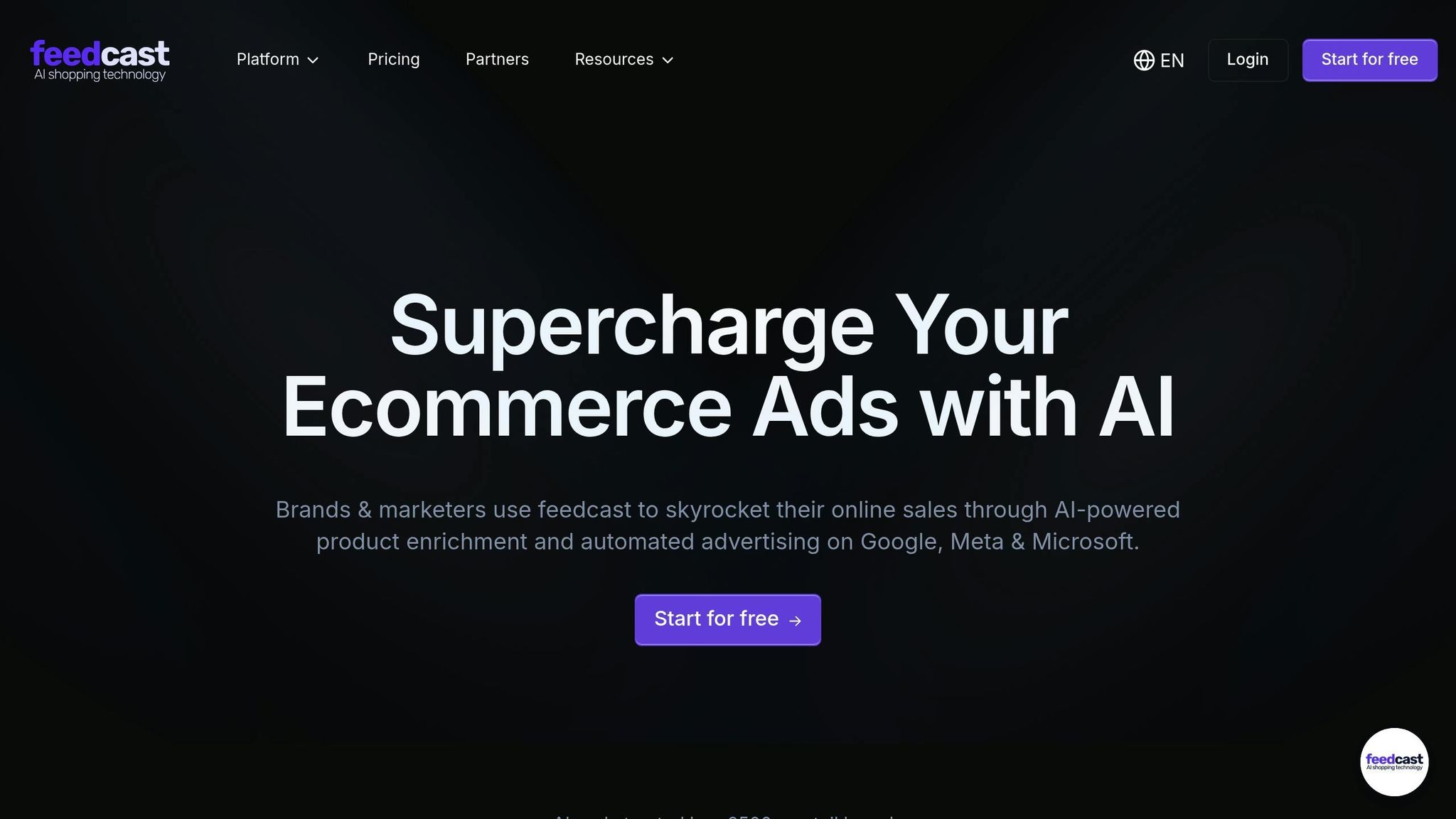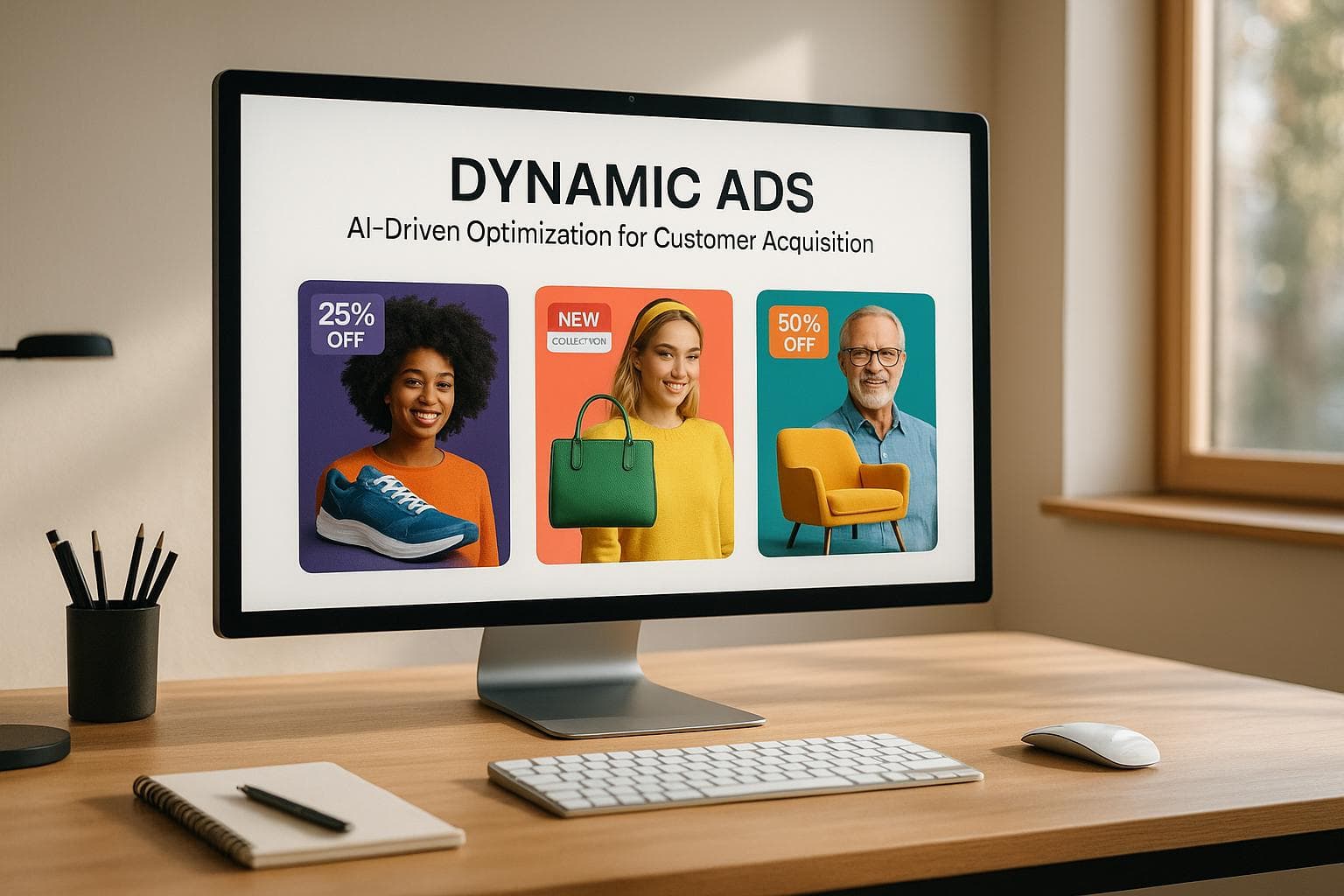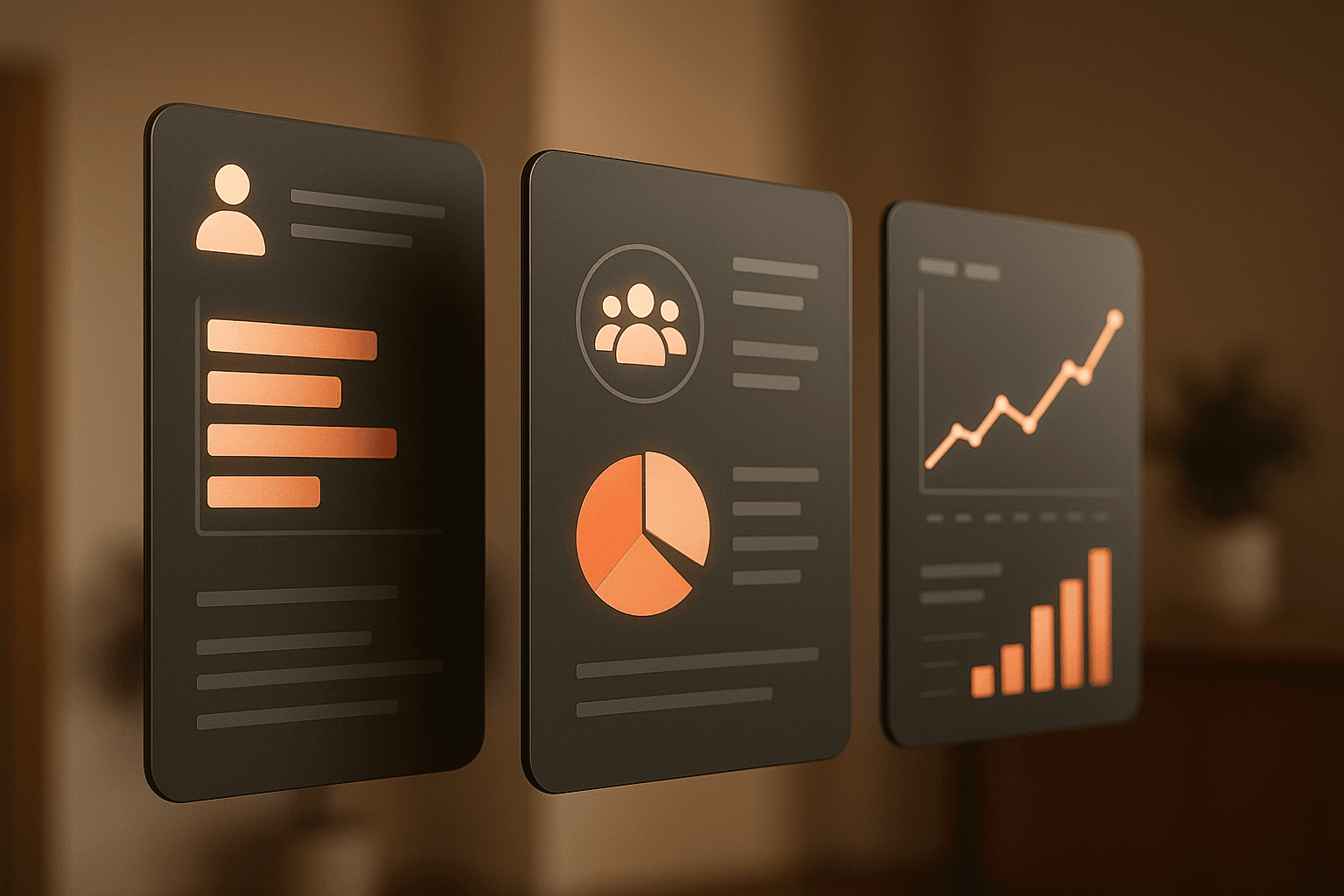How AI Optimizes Ad Copy Length
Explore how AI tools streamline ad copy creation by optimizing length, enhancing performance, and ensuring compliance across various platforms.
AI tools are transforming how businesses create ad copy for platforms like Google, Facebook, and Instagram. By analyzing platform-specific character limits and performance data, AI generates tailored ad variations that save time and improve results.
Here’s why it matters:
- Saves Time: AI reduces the time spent on crafting ad copy by 30–50%.
- Platform-Specific Optimization: Automatically adjusts copy to fit character limits (e.g., Google Ads headlines max at 30 characters, while Instagram Feed allows up to 40).
- Improves Performance: AI analyzes metrics like click-through rates (CTR) and return on ad spend (ROAS) to refine ad copy continuously.
- A/B Testing: AI tests multiple variations to find the most effective copy for each platform and audience.
- Consistency: Maintains brand voice while ensuring compliance with platform rules.
For example, tools like Feedcast.ai automate ad copy creation, compliance checking, and performance tracking, helping businesses focus on strategy while boosting ad effectiveness. AI not only simplifies the process but ensures ads resonate with audiences across all platforms.
AI For Ad Copy - Easy Ad Copy Method Using Free AI Tools
Platform-Specific Ad Copy Requirements
Every advertising platform has its own set of rules and character limits, which can vary not only by platform but also by ad placement. This makes creating tailored, manual ad copy a time-consuming task. But understanding these requirements is essential to ensure your ads aren't cut off or rejected, and that they reach their full potential for visibility and engagement[2]. The complexity of these limits calls for precision, something AI handles with ease.
For example, Google Ads has stricter guidelines compared to Bing Ads, requiring your copy to be more concise and compliant[1]. Meanwhile, platforms like Facebook and Instagram, which collectively reach over 3 billion users worldwide, emphasize the importance of ad copy compliance. Even small adjustments can lead to noticeable improvements in campaign performance.
Ad Copy Length Guidelines by Platform
Getting the character limits right is critical for a successful ad campaign. Here's a quick look at the key limits across popular platforms:
| Platform | Ad Element | Character Limit |
|---|---|---|
| Google Ads | Headline | 30 |
| Google Ads | Description | 90 |
| Bing Ads | Description | 80 |
| Facebook Feed | Primary Text | 80 |
| Facebook Feed | Headline | 27 |
| Instagram Feed | Primary Text | 125 |
| Instagram Feed | Headline | 40 |
| Facebook Reels | Primary Text | 40 |
| Facebook Reels | Headline | 55 |
| Instagram Reels | Primary Text | 72 |
| Facebook Stories | Primary Text | 125 |
| Facebook Stories | Headline | 40 |
| Instagram Stories | Primary Text | 125 |
These differences highlight the challenges of crafting ad copy manually. For instance, Google Ads allows only 30 characters for headlines, while Instagram Feed headlines can go up to 40 characters[1]. A well-crafted message on one platform could be incomplete or cut off on another, making it crucial to tailor your text for each placement.
Meta platforms, such as Facebook and Instagram, offer a feature called placement asset customization. This lets you adjust ad copy for specific placements across Facebook, Messenger, Instagram, and the Meta Audience Network[2]. For example, you can create an 80-character version of your primary text for Facebook Feed, while trimming it down to 40 characters for Facebook Reels.
While knowing these limits is essential, the real advantage lies in leveraging AI tools. AI can analyze and adjust your ad copy to fit each platform's constraints without losing clarity or impact. This approach not only saves time but also ensures your message resonates with the audience, no matter where it appears.
How AI Analyzes and Adjusts Ad Copy Length
AI has revolutionized ad copy optimization, using machine learning and natural language processing (NLP) to fine-tune content for context, tone, sentiment, and brand voice. This ensures your ad copy aligns with platform requirements without losing its punch. By analyzing performance metrics and audience preferences, AI continuously refines its recommendations, making each iteration smarter and more effective.
The process begins with AI evaluating the performance of your existing ad copy. Machine learning models study conversion rates and engagement metrics, learning what resonates with your audience. As new data rolls in, these models adapt in real time, offering fresh insights and adjustments.
Sentiment analysis is a key part of this process. By gauging how consumers feel about your brand, products, or services, AI can tweak the tone and length of your copy to better connect with your audience. This ensures your message hits home, even when platforms impose strict character limits.
Creating Platform-Specific Copy Variants
One of AI’s strengths is its ability to generate tailored ad copy for different platforms. It starts by dissecting your original content, identifying its critical elements - like your value proposition, emotional triggers, and call-to-action. From there, it crafts variations that meet specific platform guidelines while keeping your message intact.
For example, if your original headline is 45 characters, AI can create a 30-character version for Google Ads or a 40-character version for Instagram Feed, all while maintaining the same persuasive tone. This isn’t just about shortening text; AI ensures each version retains clarity and impact.
Beyond character limits, AI personalizes content based on user data like preferences, behaviors, and demographics. This level of customization would be nearly impossible to achieve manually across multiple platforms.
Keyword optimization is another critical aspect. NLP algorithms identify high-performing keywords for each platform, ensuring even shortened versions of your copy include terms that drive engagement and conversions.
Balancing Creativity and Compliance
AI doesn’t just meet platform constraints; it balances them with creative storytelling. It understands the hierarchy of information in your copy, pinpointing the elements that are essential for maintaining impact and trimming less critical parts. This way, even the shortest versions of your content remain compelling.
Consistency across platforms is another benefit of AI-driven optimization. While adapting your copy to fit different character limits, AI ensures your brand voice and messaging strategy stay consistent. This consistency is vital for building trust and recognition, no matter where your audience encounters your ads.
AI also tailors your copy to the unique context of each platform. For instance, what works on Facebook’s news feed might need a different approach for Instagram Stories, even if the character limits are similar. AI picks up on these nuances and adjusts accordingly.
Machine learning models continuously refine this process by analyzing campaign performance. They identify which creative elements resonate most on each platform and prioritize preserving those in future iterations. This ongoing cycle of learning and adjustment ensures your ad copy not only complies with platform requirements but becomes increasingly effective over time, seamlessly integrating into Feedcast.ai’s ad copy creation process.
sbb-itb-0bd1697
Optimizing Ad Copy Length with Feedcast.ai

Feedcast.ai takes the hassle out of ad copy optimization by aligning with the latest platform guidelines, freeing e-commerce businesses to focus on strategy. The tool is equipped with detailed knowledge of each platform's specific requirements. For example, LinkedIn Sponsored Content headlines are fine-tuned to fit within 25–45 characters. This ensures that every piece of copy generated by the system adheres to platform standards without the need for manual checks.
A key feature of this process is AI-powered data enrichment. When you upload product data, Feedcast.ai doesn’t just trim or resize content - it enhances it. By analyzing market trends and performance data, the platform improves product titles, descriptions, and attributes. The result? Shortened ad copy that’s not only platform-compliant but also packed with relevant keywords and engaging language designed to capture attention and drive results.
With its unified dashboard, Feedcast.ai offers real-time insights into how different copy lengths perform across all connected channels. This makes it easy to identify the variants that generate the best click-through and conversion rates, helping you make informed decisions for future campaigns. It’s a streamlined, data-driven approach to ad creation that saves time and maximizes impact.
Automating Ad Copy Creation
Getting started with Feedcast.ai is simple. You can import product data directly from platforms like Shopify, WooCommerce, and Prestashop, or upload files in formats like Google Sheets, CSV, or XML. Once your product details are in the system, the AI engine gets to work, generating multiple headline and description options tailored to the specific requirements of each advertising channel.
The platform analyzes your product's key selling points and transforms them into engaging copy that fits within each platform's character limits. For instance, if you’re launching a product across Google, Facebook, and Microsoft Ads, Feedcast.ai will create unique versions optimized for each platform’s audience and format, all while staying true to your brand voice and messaging.
Real-time compliance checking is another standout feature. The AI continuously monitors character counts and flags or adjusts content automatically to ensure compliance with platform limits. This prevents issues like truncation or ad rejection, saving time and reducing wasted ad spend.
Feedcast.ai doesn’t just shorten text - it intelligently restructures it to deliver maximum impact. The platform keeps your key messaging intact while trimming unnecessary details, ensuring every word counts.
A/B Testing Ad Copy Length
Once tailored ad copy is generated, Feedcast.ai takes it a step further with systematic A/B testing. The platform automatically creates multiple variants with different lengths and formats, distributing them across campaigns to find the top performers. This process helps identify which copy styles resonate most with your audience on each platform.
The testing tracks critical metrics like click-through rates, conversion rates, and engagement for each variant. These insights feed back into the AI, creating a learning loop that refines future copy generation. With each iteration, your campaigns become smarter and more effective.
Feedcast.ai also adapts to platform-specific contexts. For example, a headline that works well on Facebook’s news feed might need adjustments for Instagram Stories. This ensures that you’re not just finding the right copy length but also the most effective messaging for each placement and audience.
All A/B testing results are displayed in the platform’s unified dashboard. You can segment data by copy length, platform, and audience demographics, giving you a clear view of what works and why. These insights go beyond individual campaigns, helping you make broader strategic decisions and reinforcing Feedcast.ai’s focus on continuous improvement through data-driven insights.
Measuring Results and Continuous Improvement
To see if your ad copy efforts are paying off, tracking key metrics is non-negotiable. With digital ad spending soaring to $600 billion annually, businesses need clear, actionable insights to stay competitive [4]. Yet, nearly 47% of marketers admit they struggle to measure ROI effectively [4]. That’s where robust analytics tools come into play.
The secret lies in focusing on the right metrics. Cost per click (CPC) helps gauge efficiency, while return on ad spend (ROAS) reveals whether your campaigns are profitable. For example, businesses that fine-tune their ROAS can see returns of up to 400% on their ad investments [4]. Metrics like engagement rate, bounce rate, and average time on site go a step further, showing how well your ad copy connects with your audience and mapping the customer journey from click to conversion.
Using Feedcast.ai's Performance Analytics
Feedcast.ai simplifies performance tracking with its all-in-one dashboard, bringing together data from platforms like Google, Facebook, Instagram, and Microsoft Ads. It offers real-time insights into critical metrics such as CTR, conversion rates, and ROAS, helping you quickly pinpoint which ad variations deliver the best results.
What sets Feedcast.ai apart is its granular analytics. The platform breaks down performance by copy length, platform, audience, and even device. This detailed view doesn’t just show you what works - it helps explain why it works. For instance, you might notice that shorter headlines perform better on mobile, whereas longer descriptions drive more conversions on desktop.
Customizable reporting features allow you to tailor dashboards to your needs. You can track trends over time, compare campaign performance, and uncover patterns that might not be obvious with day-to-day monitoring. On top of that, the platform evaluates landing page behavior - such as bounce rates and time spent on site - giving you a complete picture of ad performance. With over 60% of marketers relying on metrics like click-through and conversion rates to adjust their strategies [4], Feedcast.ai simplifies the process by automatically flagging underperforming ads and highlighting areas for improvement. Its real-time tracking ensures you can address issues quickly, avoiding wasted budget. All these insights seamlessly integrate into the platform’s AI-driven optimization process.
AI-Driven Feedback Loops
Feedcast.ai leverages real-time data to refine future ad campaigns. The platform’s AI creates a feedback loop that collects performance data, identifies patterns, and applies those insights to generate smarter ad copy. This system ensures your campaigns evolve with each iteration.
For example, if shorter headlines consistently lead to higher CTRs on Instagram, the AI learns from this and applies it to future campaigns. Over time, your ad copy becomes more effective without requiring constant manual adjustments.
But it doesn’t stop at headline length. The AI analyzes which combinations of headlines, descriptions, and calls-to-action work best together. For instance, personalized calls-to-action have been shown to convert 202% better than generic ones [5]. Feedcast.ai identifies these trends and incorporates them into new ad variations automatically.
The feedback loop also pulls data from diverse sources like customer surveys, social media comments, and product reviews. This ensures optimization decisions are grounded in real customer behavior, not guesswork. The AI continuously monitors performance, adjusting parameters as needed. If shorter headlines outperform longer ones for a specific product, the system prioritizes brevity in future campaigns. It even detects seasonal trends, audience shifts, and platform-specific behaviors, helping you fine-tune your long-term strategy. With Feedcast.ai, your ad copy stays sharp, responsive, and aligned with live market feedback.
Conclusion
AI-powered tools are reshaping how ad copy is created, turning what used to be a manual and time-intensive process into something faster and data-driven. With the help of natural language processing and machine learning, these tools can produce multiple ad copy variations in just seconds, saving both time and effort compared to traditional methods[3].
These tools don't just speed up the process - they ensure your messaging remains creative while meeting the specific requirements of each platform. Whether it's character limits or tone consistency, AI adjusts automatically, ensuring your brand voice stays intact and your ads are effective.
One standout example is Feedcast.ai, which simplifies ad management by offering a centralized platform for handling ad copy across multiple channels. Its AI system not only tailors copy to fit platform-specific needs but also learns from performance data to continuously improve your campaigns. Features like automated A/B testing identify the best-performing copy styles and lengths for your audience, making optimization a seamless process.
By keeping your ad copy compliant, relevant, and optimized for each platform, AI tools help boost ROI through smarter ad spending and better campaign results. The automated feedback loops mean your campaigns can adapt to evolving audience preferences and platform changes without constant manual updates.
For e-commerce businesses running ads on platforms like Google, Facebook, Instagram, and Microsoft Ads, AI-driven ad copy optimization has become a necessity. It handles the technical aspects of compliance while giving marketers more time to focus on strategy and creativity. This combination of efficiency and performance ensures businesses can stay competitive and maximize their campaign results with less effort.
FAQs
How does AI create ad copy that matches a brand's voice while staying within platform-specific character limits?
AI uses sophisticated algorithms to align with your brand's voice and meet the specific requirements of platforms like Google, Facebook, and Instagram. It adjusts tone, style, and messaging while automatically following character limits and formatting rules for each platform.
By reviewing past content and applying your brand's guidelines, AI ensures your messaging stays consistent. It also tweaks ad copy to match the preferences of each platform's audience, making your ads resonate and perform well across different channels.
How does AI measure and improve the performance of ad copy across platforms?
AI reviews important performance metrics like impressions, clicks, click-through rate (CTR), conversions, and cost per acquisition (CPA) to figure out which ad variations deliver the best results. By diving into these data points, it uncovers patterns and areas where improvements can be made.
On top of that, AI uses real-time engagement data and audience targeting insights to fine-tune ad copy and boost campaign performance. This flexible strategy helps create ads that resonate more effectively across various platforms, leading to stronger results over time.
How does Feedcast.ai help ensure ads meet platform requirements and avoid issues like rejection or truncation?
Feedcast.ai employs real-time compliance checking to make sure your ads align with each platform's specific rules. As you set up and manage campaigns, the system automatically reviews your product feed data and ad content, comparing them against platform policies. It quickly spots and fixes common issues like mismatched attributes, invalid product IDs, and policy violations.
By catching these problems early, Feedcast.ai reduces the chances of your ads being rejected or cut off. This process helps keep your campaigns running smoothly and ensures your ads are polished and ready to perform before they go live.
Yohann B.










